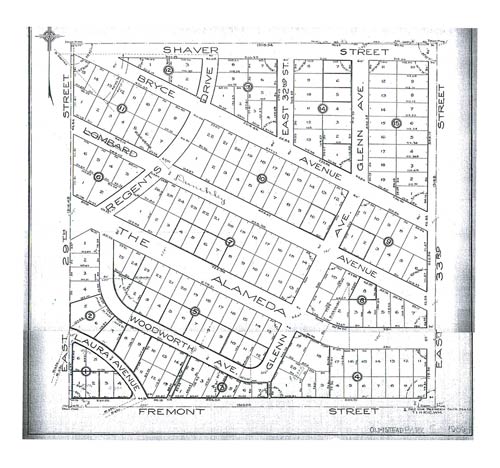
Here’s the cadastral map from 1909 showing the Olmstead Park plat. This roughly five-block square area is north of the Alameda Ridge and tucks in under the southeast corner of Alameda Park. Today this part of the neighborhood is clearly considered part of the Alameda District. Out on the ground even in 1911, these two brand new districts were indistinguishable, interwoven by the same streets, the same water, gas and sewer mains, and many of the same architects and builders who were beginning to populate this area with homes.
The Olmsted in “Olmstead Park” was probably John Charles Olmsted, stepson and nephew of the legendary landscape architect Frederick Law Olmsted (this is not a typo…someone added an “a” into the plat name over the years). John Charles Olmsted and his brother Frederick Law Olmsted, Jr. helped design Portland’s park system and were busy with other commissions here in Portland — including one for the Alameda Land Company — in the years after the 1905 Lewis and Clark Exposition (which they also designed).
By 1909, the neighborhoods to our north and south were already established, and the Portland Railway, Light and Power Company was opening its Broadway Streetcar line with a connection to the heart of Alameda Park and Olmstead Park.
In 1910, before home construction was underway, much of the property in Olmstead Park was owned by one man: B.M. Lombard, a real estate developer who owned large tracts in north and northeast Portland, and whose name is memorialized by North Portland’s Lombard Street. In fact if you look at the plat, you can see that today’s Dunckley Avenue was originally platted as Lombard. Other properties were owned by construction companies, investment banks and real estate developers, including Oregon Home Builders Inc., Colonial Construction Co., Hibernian Investment Bank, Provident Trust Company and Clodfelter Real Estate.
I’ll keep a copy of this in “The Maps” for future reference…

Somewhere along the line, Lombard became Dunckley, and Glenn became 32nd Place.
Exactly right. And Laura became Edgehill. Even though Lombard was on the plat map, I believe it never made it to the actual street…it’s always been Dunckley. Glenn, on the other hand, was Glenn until 1931. And then there is Alameda Terrace (in the Olmsted Park addition) which was Woodworth until the early 1930s until taking the name we know today. For more on the background behind our local street names, have a look at the page here on this site: https://alamedahistory.wordpress.com/alameda-stories/alameda-street-names/
Hi Doug,
This is so exciting…a friend just gave me the book “The Devil in the White City” to read. It is actually kind of a murder mystery, but centers around the 1893 World’s Fair and the landscape architect Olmstead. My friend then described the Vanderbilt home back in South Carolina that she had visited that was also landscaped by Olmstead at the same time he was designing the world’s fair project. The name stuck a cord with me, I googled Olmstead Park, Portland, Oregon and lo and behold, found your website and my my street Edgehill Place, which I never knew was previously named Laura! Our original number was 999, …I wonder what other street secrets there are?! Anyway, just thought this was fun and I learned something and wanted to say thank you!
Hi Doug,
I attended your lecture today at AHC. Enjoyed learning about my neighborhood. My property is in Alameda Park but includes the very northeast corner of Olmstead Park,a sliver of land. Your lecture helped to explain why both are mentioned on my deed.
Thanks!
Hi Helen. Thanks for coming to the lecture today, and for your note here on the website. I enjoyed meeting many neighbors and learning more about the neighborhood myself.
-Doug
Hi. I know this is an old thread, but giving it a shot. I am trying to find the original address (Woodworth Ave) for what is now 3020 NE Alameda Terrace. Thanks.
Hi Dana. Prior to 1931, 3020 NE Alameda Terrace was 904 Woodworth.
-Doug